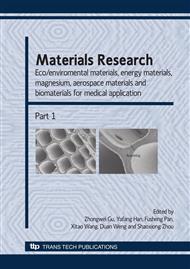p.76
p.81
p.85
p.97
p.104
p.109
p.114
p.120
p.125
Silsesquioxane Materials as Sun Protection Factor Ingredients and as Films for Greenhouse Covers
Abstract:
Using polyhedral oligomeric silsesquioxanes (POSS) derived from the hydrolytic condensation of (3–methacryloxypropyl)trimethoxysilane (MPMS), vinyltrimethoxysilane (VMS), and (3-glycidoxypropyl)trimethoxysilane (GPMS), three hybrid nanofilms, f-MP (film-MPMS-POSS), f-GP and f-VP, were prepared using sol-gel and crosslinking processes. The average transparency (AT) and absorption coefficents (AC) of the films were measured in the ranges of 280-2500 nm. Two film transparency applications are described in this work: 1) The AT values of the POSS films in the range of the ultraviolet B (UV-B) spectrum (280–320 nm) (a skin cancer-causing agent) and 2) the AT values in the visible light (VIS) region (400-750 nm) and the near infrared (NIR) region (750-2500 nm) (providing crops growth energy and the improvement of the photosynthetic process efficiency). The AT values of the POSS films in the UV-B range are only about 13%, indicating these films can provide a physical barrier to block UV-B absorption by the skin, and therefore are possible POSS materials for sunscreen ingredients. The AT values in the VIS region are 95.13%, 89.16% and 91.60%, respectively, and the AT values in the near infrared (NIR) region (750-2500 nm) are 95.39%, 93.11% and 90.50%, respectively. These high AT films are good candidates for greenhouse covers. The AT values among the three films in the 280-2500nm region are different and exhibit varied selectivity for absorbed spectra due to the dissimilar sizes of organic branches covalently bonded to the silica network in the film structure.
Info:
Periodical:
Pages:
104-108
Citation:
Online since:
January 2009
Authors:
Price:
Сopyright:
© 2009 Trans Tech Publications Ltd. All Rights Reserved
Share:
Citation:


